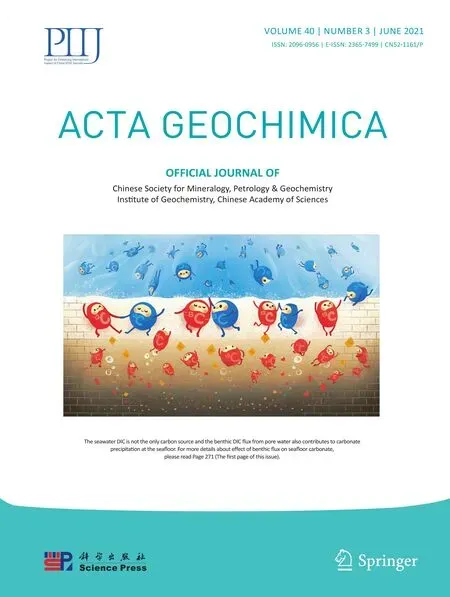Geochronological and geochemical comparison of Precambrian meta-maf ic volcanics in Zhongtiaoshan and Lu¨liangshan Regions in Shanxi,North China Craton
Baishun Shi·Jianzhong Liu·Yongquan Li·Kai Zhu·Li Zhang·Junhao Hu·Jingwen Liu,4,5
Abstract To unravel the geochemical heterogeneity and its origin in different terranes of North China,we conducted geochronological and geochemical analyses of the meta-maf ic rocks from the Lu¨liang–Zhongtiao rift zone(Shanxi Province).LA-ICP-MS zircon U–Pb dating yielded mostly End-Neoarchean to Proterozoic ages for the basement rocks(Sushui Complex:2516±26 Ma;Metamaf ic rocks: 2494±31 Ma), Jiangxian Group(~2213 Ma),Zhongtiao Group(2077±29 Ma),Jiehekou Group (1998±23 Ma), and Lu¨liang Group(2152±52 Ma).Petrographic characteristics show that the meta-maf ic rocks from the Neoarchean–Paleoproterozoic Zhongtiaoshan(Sushui Complex)have similar geochemical characteristics to the overlying Jiangxian and Zhongtiao Groups.The Paleoproterozoic Lu¨liang and Yejishan Group meta-maf ic rocks from Lu¨liangshan also have similar geochemical characteristics but are geochemically different from similar-age rocks from Zhongtiaoshan.This shows that the late-stage rocks have a geochemical inheritance from the early-stage rocks in the same region and that the geochemical heterogeneity of rocks from different areas was originated from the inherited heterogeneity of the magma source.
Keywords Geochemical heterogeneity·Geochronological and geochemical·Meta-maf ic rocks·Lu¨liang–Zhongtiao rift zone·Neoarchean–Paleoproterozoic
1 Introduction
Modern geological,geochemical and geophysical studies indicate distinct horizontal and vertical heterogeneities in mantle chemistry and isotopes,which likely exist since the Archean(Jahn et al.1987).For instance,in the North Atlantic Archean craton Eoarchean(3.8–3.7 Ga)(Garbenschiefer amphibolites)arc meta-maf ic rocks from the southern and northern terranes of the Isua greenstone belt are geochemically different,in which those from the northern terrane contains higher Y/Tb,Sr/Nd,and Ba/La,but lower La/Yb ratio than their southern counterpart(Polat and Hofmann 2003;Hanika et al.2011,2013;Oneil et al.2016).In the Pilbara craton(Western Australia),metamaf ic rocks from the East Pilbara terrane(EP)and West Pilbara Superterrane (WPS)are also geochemically heterogeneous,with the EP rocks having higher and morevaried Sr/Nd ratios,but lower La/Yb and Nb/Yb ratios(Gruau et al.1987;Smithies et al.2004;Smithies et al.2005a;Sun and Hickman 1999;Arndt et al.2001).Similarly,the widely-exposed Precambrian meta-maf ic rocks in the North China craton(Fig.1)also contain distinct geochemical heterogeneity:the southern of the Trans-North China Orogen(Lengkou,Ruzhou,Zhongtiaoshan,and Lushan)generally contain higher and wider-range Y/Tb,Sm/Nd,Nb/La,Th/La,Ba/La,and Sr/Nd ratios than the northern of the Trans-North China Orogen(e.g.,Chongli and Lu¨liangshan)(Liu 2000).
The North China Craton has an ancient history of 3.8 billion years.Compared with other cratons in the world,the area of the North China Craton is smaller,but it has experienced complex multi-stage tectonic evolution,recording almost all the major tectonic events in the early development of the Earth.The North China Craton is a natural laboratory for studying geological science and continental evolution(Zhai 2019).The Precambrian tectonic division and tectonic units of the North China Craton have attracted much attention of scholars at home and abroad.Zhang et al.(1998)divided the Early Precambrian basement of the North China Craton into 15 parts,including 9 continental crusts and 6 basement active zones,and considered that the greenstone formation(volcano sedimentary formation with different degrees of metamorphism)is an important material mark of the basement geotectonic division.Zhao et al.(1998,2005)divided the Precambrian basement of the North China Craton into two blocks:the eastern block and the western block according to the Trans-North China Orogen in the central part of the North China Craton.At about 1.85 Ga,the western block subducted eastward toward to the eastern Block caused continental-(arc-)continental collision and merged to form a unif ied Early Cambrian basement of the North China Craton.Zhai et al.(2000,2007)and Zhai(2011)divided the North China Craton into seven major micro-continental blocks (Jiaoliao,qianhuai,Ordos,Jining,Xuchang,Xuhuai,and Alxa)by identifying important ancient tectonic boundaries.They considered that the formation of the North China Craton experienced two stages of cratonization.Faure et al.(2007)divided the Archean basement of the North China Craton into three parts:the Ordos block,the Fuping block and the eastern block,and considered that the convergence of the Precambrian basement of the whole North China Craton was completed by the East–West collision events along the Trans-North China Belt in two stages of~2.1 and~1.9 Ga.Although there have been controversies over the formation mechanism of the Early Precambrian basement of the North China Craton and the age of assembly,there has been a basic consensus that the Precambrian basement of the North China Craton was composed of several pre-existing micro-continental blocks(Xiao and Liu 2015).

To investigate the origin of such regional heterogeneity and provide more evidence for Ouyang Ziyuan’s theory of the origin and evolution of the planetary Earth’s heterogeneity,we studied the meta-maf ic rocks from the Zhongtiao-Lu¨liang rift(Shanxi province).The reason to choose this region as the research object was mainly based on the following considerations:(1)both Lu¨liangshan and Zhongtiaoshan have the same tectonic background,and it can be ruled out that the difference of composition in the rock formation was caused by the different tectonic positions;(2)both regions have Neoarchean basement,and their respective overlying Paleoproterozoic sequences are of similar ages,which avoids the geochemical deviation was caused by time evolution;(3)the whole rift zone has undergone the same metamorphic and deformation processes,which can eliminate the difference of geochemistry of rock formation in different areas was caused by any latestage geological process.In this way,we can draw a more objective conclusion(Liu and Ouyang 2003).
2 Regional geological background
2.1 Zhongtiaoshan metamorphic supracrustal rocks
Zhongtiaoshan metamorphic supracrustal rocks are located in southern part of the Central Orogenic Belt(North China Craton).Precambrian stratigraphy is distributed in a NNEtrend,and comprises(from bottom up)Neoarchean–Paleoproterozoic Sushui Complex,Paleoproterozoic Jiangxian,Zhongtiao,and Danshanshi Groups,together with the overlying Mesoproterozoic Xiyanghe Group(Fig.2).The Sushui Complex is situated in the northwestern side of Zhongtiaoshan.It represents the oldest lithologic unit there,and is in unconformable contact with the overlying Paleoproterozoic/Mesoproterozoic sequences(Zhang et al.2013).The complex contains mainly tonalite–trondhjemite–granodiorite(TTG)gneiss,metamorphosed calcalkaline granites and subalkaline granites,together with meta-volcanics plus minor meta-supracrustal rock inclusions and meta-maf ic sheeted dikes(Sun and Hu 1993;Zhang et al.2003).The Jiangxian Group occurs as wedgeshaped in the eastern side of the Sushui Complex(northern section).Its lower part(Henglingguan Subgroup)and upper part(Tongkuangyu Subgroup)are featured by clastic sedimentary rocks and volcanic-volcaniclastic rocks,respectively.The Henglingguan Subgroup is in angular unconformity with both the underlying Sushui Complex and the overlying Tongkuangyu Subgroup(Zhao 2013;Liu et al.2015).The Zhongtiao Group is a suite of meta-carbonate sequences,and contains minor metamorphosed volcanic and clastic rocks.It displays also angular unconformable contact with the underlying Jiangxian Group and Sushui Complex.Danshanshi Group is a suite of metaglutenite sequence,and overlies the Jiangxian and Zhongtiao Groups along an angular unconformity,and underlies the Xiyanghe Group along an angular or parallel unconformity(Liu et al.2015).In the Zhongtiaoshan region,the Xiyanghe(also called Xiong’er)Group contains mainly a suite of volcanic(mainly intermediate and minor maf ic and felsic)-sedimentary formation(Li et al.2008),and underlies the Ruyang Group siltstone along a lowangle unconformity(Liu et al.2007).
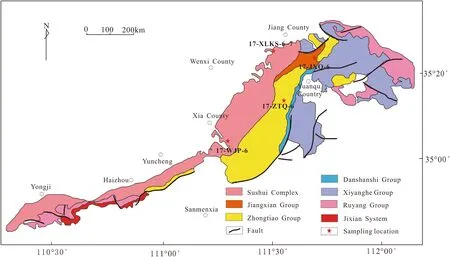
Fig.2 Geological sketch map of the Zhongtiaoshan region(modif ied after Zhang et al.2013)
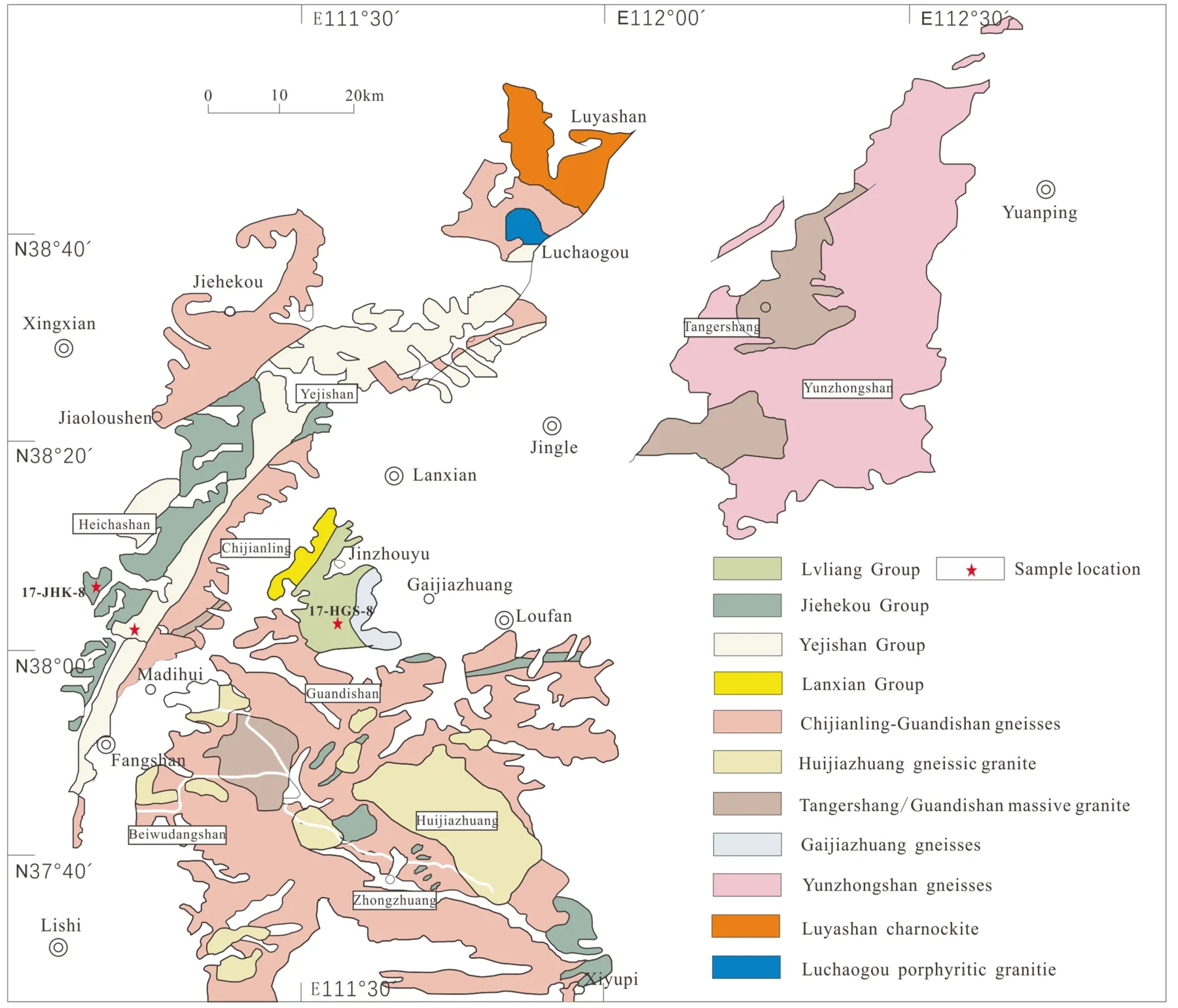
2.2 Lu¨liangshan metamorphic supracrustal rocks
The Lu¨liangshan metamorphic supracrustal rocks are located in the middle part of the Central Orogenic Belt and comprise(from bottom-up)the Jiehekou,Lu¨liang,Yejishan,and Lanxian Groups(Fig.3).Alternatively,some studies considered that these groups were formed at similar time and have no vertical stratigraphic relations,i.e.,they have been structurally juxtaposed together or are of different coevally-deposited facies(Hou et al.2006;Liu et al.2007).The Jiehekou Group is located in the NW of the Lu¨liang Complex,and has a NNE-SSE-trending distribution that extends across the Lu¨liang region from Jiaoloushen and Aojiatan(Xing county)to the Hangaoshan in the east.The group is also locally exposed at Xiyupi-Dongshe(Wenshui county)and Mijiazhuang(Jiaocheng county).The Jiehekou Group comprises mainly a suite of garnet-sillimanite-bearing two-mica schist in a graphitic marble,quartzite,leptynite and plagioclase amphibolite assemblage(Tian et al.2014).The Lu¨liang Group has a generally NS-trending distribution in the central part of Lu¨liang, around Jinzhouying-Huanggushan-Luojiacha(Loufan county).Rocks of the Lu¨liang Group have generally experienced lower greenschist-to amphibolite-facies metamorphism.Its lower part(Yuanjiacun and Peijiazhuang Formations) contains mainly sedimentary sequences,whilst the Jinzhouying and Dujiagou Formations of its upper part contain meta-basalt and meta-rhyolite,respectively(Wang 2014;Guo 2015).Yu et al.(1997,2004)considered that the Jinzhouying and Dujiagou Formation volcanics constitute a bimodal volcanic assemblage.The Yejishan Group is located in the NW of the Lu¨liang Complex.Its exposure is the widest at around Yejishan,and is in ductile shear contact with the Jiehekou Group to the west.The group comprises a terrigenous clastic-volcanic suite and experienced greenschist-facies metamorphism(Liu et al.2009).The Lanxian(or Heichashan)Group is generally considered to belong to the Yejishan Group and represents a suite of coarse-grained glutenite at the top part of the Yejishan Group(Liu et al.2013).
3 Sampling locations and petrographic features
In this study,we collected six meta-maf ic rock samples from the various groups in the Zhongtiaoshan and Lu¨liangshan region and performed geochemical analysis and LA-ICP-MS zircon U–Pb dating on all the samples.
3.1 Meta-maf ic rocks(Sushui Complex)
We sampled the Sushui Complex meta-maf ic rocks from Xilengkoushan and Wenjiapo(Xia county).The Xilengkoushan meta-maf ic rock sample(17XLKS;35°2559.42N,111°2937.42E)is dark grey,massive,partly schistosedeformed.Under the microscope,the sample shows porphyroblastic granular texture and has mainly amphibole(~70%)and plagioclase(~30%).The sample is thus classif ied as a plagioclase amphibolite(Fig.4).The Wenjiapo meta-maf ic rock sample(17WJP)is collected next to the Wenjiapo 836 county highway (N35°0439.39,E111°1851.90).The rocks appear dark grey in the f ield.Under the microscope,the sample contains mainly amphibole(~65%)and plagioclase(~30%),together with minor quartz(~5%)(Fig.4).The sample is classif ied as plagioclase amphibolite by its mineral assemblage.

Fig.4 Field photos and thin-section photomicrographs of the samples from the Sushui Complex meta-maf ic rocks:a features of the meta-maf ic rocks of the Xilengkou-Sushui complex;b features of the meta-maf ic rocks of the Wenjiapo-Sushui complex;c,d photomicrographs of sample 17XLKS;e,f photomicrographs of sample 17WJP c,e plane polarized light;d,f cross polarized light.Abbreviations:HBL hornblende,Pl plagioclase,Px pyroxene,Am amphibole,Ser sericite
3.2 Jiangxian Group meta-maf ic rocks
The meta-maf ic rock sample(17-JXQ)was collected from the Tong’ao Formation(Jiangxian Group),SW of the intersection between the Yuanqu smelter and the railway(35°2122.40N,111°3639.79E).The rocks are dark brown,massive,and hydrothermal altered.The rock contains mainly plagioclase(~65%),amphibole(~30%),and together with minor quartz(~5%),the amphibole occurred chloritization and the plagioclase occurred sericitization and is classif ied as plagioclase amphibolite(Fig.5).
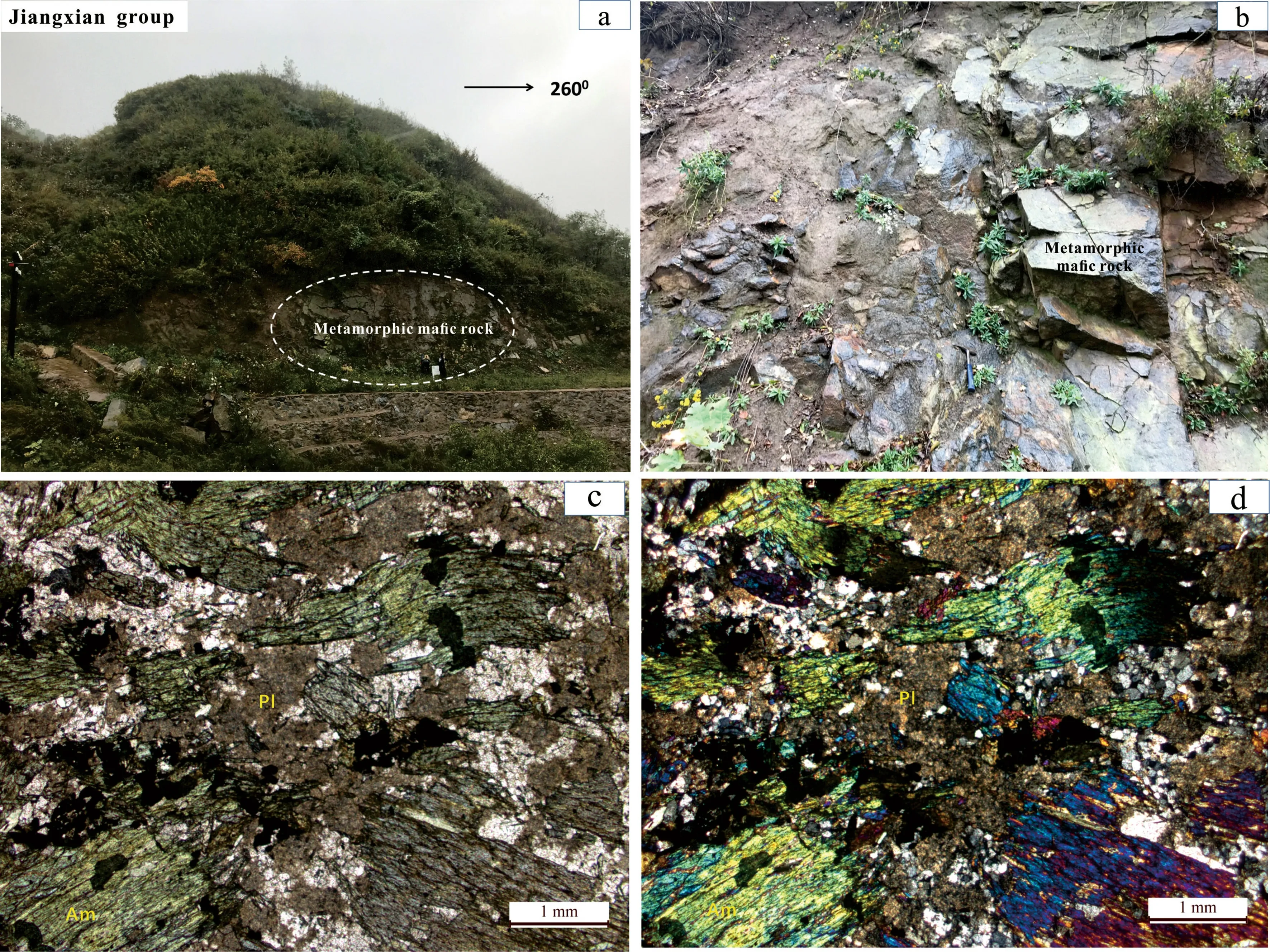
Fig.5 Field photos and thin-section photomicrographs of the samples from the Jiangxian Group meta-maf ic rocks:a,b features of the metamaf ic rocks of the Jiangxian Group;c plane polarized light;d cross polarized light
3.3 Zhongtiao Group meta-maf ic rocks
Meta-maf ic rock sample(17-ZTQ)of the bottom Bizigou Formation was collected from the SE of the quarry at Hujiayu(Beiyu)(35°1335.56N,111°3243.22E).In the f ield,the rocks are dark brown/green and massive.Under the microscope,amphibole occurs as interstitial among plagioclase grains,and both minerals are intense altered.The sample contains mainly plagioclase(~65%)and amphibole(~35%),and is classif ied as plagioclase amphibolite(Fig.6).
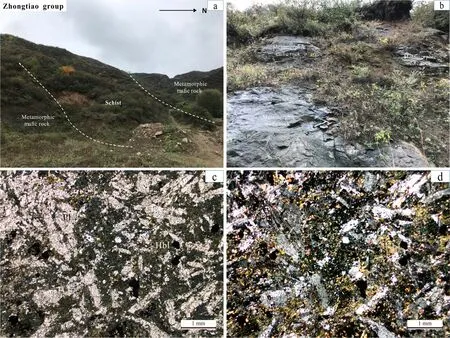
Fig.6 Field photos and thin-section photomicrographs of the samples from the Zhongtiao Group meta-maf ic rocks:a,b features of the metamaf ic rocks of the Zhongtiao Group;c plane polarized light;d cross polarized light
3.4 Jiehekou Group meta-maf ic rocks
Meta-maf ic rock sample(17-JHK)of the Yuanziping Formation(lower Jiehekou Group)was collected from near Yuanziping along the highway Yangpo reservoir—Hejiawan(Lin county)(N38°0955.32,E111°1538.78).The rocks in the f ield are generally dark grey and folded.Under the microscope,the sample shows holocrystalline texture,and contains mainly amphibole(~90%)and muscovite(~5%),and~5%accessory minerals.The sample is classif ied as amphibolite(Fig.7).
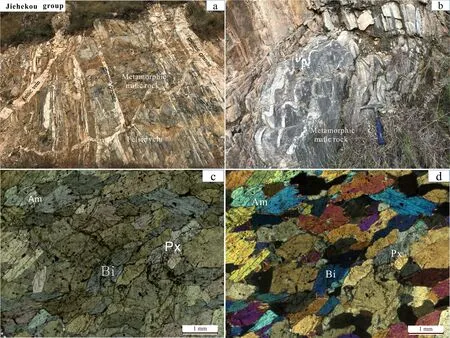
Fig.7 Field photos and thin-section photomicrographs of the samples from the Jiehekou Group meta-maf ic rocks:a,b features of the metamaf ic rocks of the Jiehekou Group;c plane-polarized light;d cross-polarized light
3.5 Lu¨liang Group meta-maf ic rocks
Meta-maf ic rock sample(17-HGS)of the Jinzhouying Formation(Lu¨liang Group)was collected from~1 km NNE of Huanggushan (Loufan, Taiyuan city)(38°0357.59N,111°3215.60E).Rocks in the f ield appear generally dark grey.Under the microscope,the phenocrysts are mainly plagioclase(about 1 mm),with f ine pyroxene microcrystals.Alteration of the pyroxene phenocrysts is relatively intense,plagioclase content more than 50%.Subvolcanic rocks have a structure similar to dikes.The sample is classif ied as metabasalt(Fig.8).
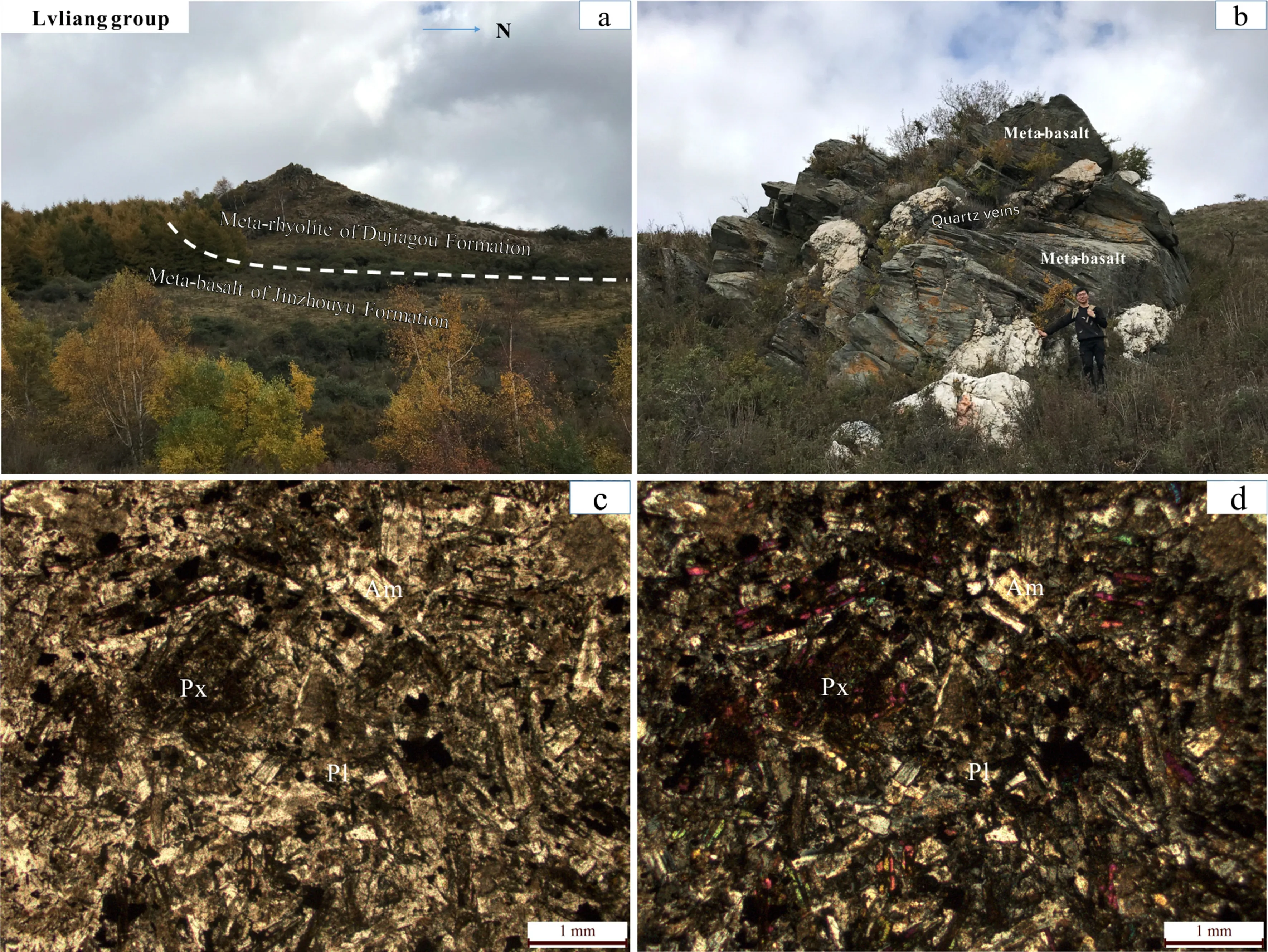
Fig.8 Field photos and thin-section photomicrographs of the samples from the Lu¨liang Group meta-maf ic rocks:a,b features of the meta-maf ic rocks of the Lvliang Group;c plane polarized light;d cross polarized light
4 Analysis methods
For the six meta-maf ic rock samples collected,whole-rock major and trace element analyses were performed at the State Key Laboratory of Ore Deposit Geochemistry,Institute of Geochemistry,Chinese Academy of Sciences.Major element analysis used the XRF method,with analytical precision better than 10%.Trace element[incl.rare earth element(REE)]analysis used the ICP-MS method analysis,with analytical precision better than 5%and detailed analytical procedures as described by Qi et al.(2000).Single-mineral separation of zircon was conducted at the Hebei Bureau of Geology and Mineral Resources(BGMR),whilst the zircon mounting,transmitted-/ref lected-light microscopic observations and cathodoluminescence(CL)imaging,and U–Pb dating were all performed at the Wuhan Sample Solution Co.Ltd.(Wuhan,China).The zircon U–Pb dating was performed with an Agilent 7700 ICP-MS coupled with a GeoLasPro 193 nm laser ablation system.Detailed analytical conditions and procedures are as described by Liu et al.(2008,2010).Data processing was performed with the ICPMS DataCal software and common Pb correction with the software by Andersen(2002).Age calculation and Concordia diagram production was done with Isoplot3(Ludwig 2003).
5 Analysis results
5.1 Whole-rock geochemical features
Analytical results for major and trace elements for six rock samples are summarized in Supplementary Table 1.
Since REE and high-f ield-strength element(HFSE)contents in rocks can remain stable under amphibolite-(or even granulite-)facies conditions(Wang et al.2015),our geochemical descriptions and discussion would focus mainly on REEs and HFSEs.
In the Zr/TiO*0.0001 versus Nb/Y petrological discrimination diagram(Fig.9),most of the Lu¨liangshan meta-maf ic rock samples(Jiehekou,Lu¨liang,and Yejishan Groups)fall inside the basalt f ield;A few samples from Zhongtiaoshan(Sushui Complex,Jiangxian and Zhongtiao Group)fall inside the andesite or basaltic andesite f ields,but most samples fall inside the basalt f ield.In the La–Yb binary diagram(Fig.9),among the Jiehekou Group samples one is calc-alkaline,and the rest are tholeiitic-transitional;one Lu¨liang Group sample is tholeiitic-transitional,and the rest are calc-alkaline;all Yejishan Group samples are calc-alkaline.For the samples from Zhongtiaoshan,the Sushui Complex samples are mainly calc-alkaline and minor tholeiitic-transitional;the Jiangxian Group samples are mainly tholeiitic-transitional,and two are calc-alkaline;the Zhongtiao Group samples are mainly tholeiitic-transitional,and two are calc-alkaline.
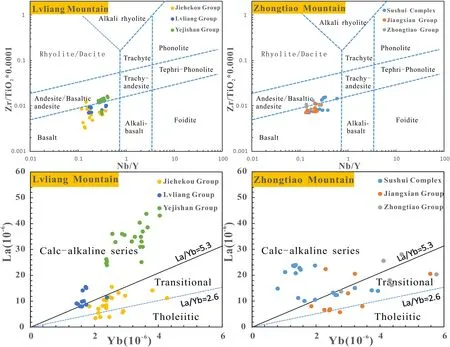
Fig.9 Zr/TiO2*0.0001-Nb/Yb and La-Yb plots for the Zhongtiaoshan and Lu¨liangshan maf ic rock samples.Base maps are from Wang et al.(2015).Some Zhongtiaoshan data are from Zhang(2015),Zhao(2006),Liu(2000),and Yang et al.(2015).Some Lu¨liangshan data are from Zhang(2017),Liu et al.(2012a),Zhao et al.(2017),Wang(2014),Data source in the following f igures is the same
In the chondrite-normalized REE diagram(Fig.10),all meta-maf ic rock samples from Zhongtiaoshan and Lu¨liangshan display slight LREE enrichments and f lat HREE(i.e.,gentle right-inclining REE)distribution patterns with no distinct Eu anomalies.As shown in Fig.10,∑REE of the Lu¨liangshan samples gradually increases from the Jiehekou Group(36.17–99.23 ppm),through the Lu¨liang Group(55.25–93.68 ppm)to the Yejishan Group(118.89–232.81 ppm);the(La/Yb)and(La/Sm)ratios also increase gradually,i.e.,1.10–4.41 and 0.84–2.26(Jiehekou Group),3.41–6.43 and 1.69–2.37 (Lu¨liang Group),and 5.17–10.04 and 2.21–3.80(Yejishan Group),respectively.For the Zhongtiaoshan samples,the∑REE also increase gradually from Sushui Complex(64.19–127.85 ppm), through Jiangxian Group(44.61–140.1 ppm) to Zhongtiao Group(83.16–165.61 ppm).The(La/Yb)and(La/Sm)ratios gradually decrease,respectively,from 2.54 to 14.83 and 1.75–3.29 (Sushui Complex),through 1.52–7.00 and 1.47–2.56(Jiangxian Group),to 2.52–4.48 and 1.54–2.40(Zhongtiao Group).In the primitive mantle-normalized multi-element diagram(Fig.11),all the Zhongtiaoshan and Lu¨liangshan meta-maf ic rock samples show various degrees of depletions in HFSEs such as Nb,Ta,and Ti.

Fig.10 Chondrite-normalized REE patterns for the meta-maf ic rocks from Zhongtiaoshan and Lu¨liangshan.Chondrite-normalizing values are from Sun and McDonough(1989)
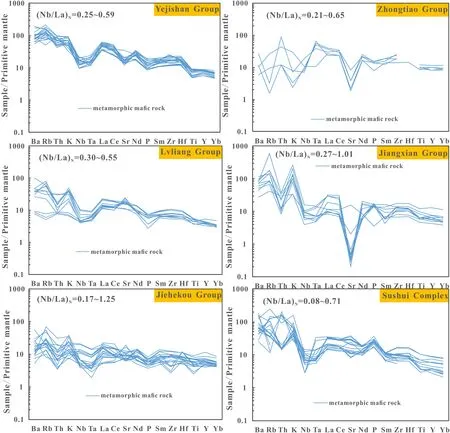
Fig.11 Primitive mantle-normalized multi-element diagrams for the meta-maf ic rocks from Zhongtiaoshan and Lu¨liangshan.Chondritenormalizing values are from Sun and McDonough(1989)
5.2 Zircon U-Pb ages
Zircons from the Xilengkoushan meta-maf ic rock sample(17-XLKS-6-7)are mainly colorless,granular(size:40–150μm).CL ref lectance is weak and most zircons developed relatively weak igneous oscillatory zoning(Fig.12).This,and the relatively high zircon Th/U ratio(0.53–6.09),suggests a magmatic origin for the zircons(Wu and Zheng 2004).LA-ICP-MS zircon analysis results are shown in Supplementary Table 2 and Fig.13.For the 23 spots analyzed,9 data points have relatively low concordance(<90%)and are thus discarded,and the remaining 14 data points are valid.In the zircon U–Pb concordia diagram,most data points fall on or close to the concordia, yielded a weighted average age of 2519±30 Ma(MSWD=0.85).A few zircons show Pb loss,with their data points fall below the concordia and along the discordia line.Upper intercept of the concordia and discordia line occurs at 2516±26 Ma(MSWD=1.5),which represents the rock formation age.

Fig.12 Zircon CL images for the meta-maf ic rock samples from Zhongtiaoshan and Lu¨liangshan
Zircons from the Wenjiapo meta-maf ic rock sample(17-WJP-6)are mainly colorless,long columnar or granular(size:100–160μm).Although the zircon Th/U ratios are relatively low(0.01–0.10),the very weak CL ref lectance and the relatively weak igneous oscillatory zoning still point to a magmatic origin(Wu and Zheng 2004).For the 25 spots analyzed,15 data points have relatively low concordance(<90%)and are thus discarded,and the remaining 10 data points are valid.In the zircon U–Pb concordia diagram,a few zircons fall on or near the concordia,whereas most zircons show Pb loss and fall below the concordia and along the discordia line.Upper intercept of the concordia and discordia line occurs at 2494±31 Ma(MSWD=0.22)(Fig.13),which represents the rock formation age.
Zircons from the Jiangxian Group meta-maf ic rock sample(17-JXQ-6)are mainly colorless,and granular or long columnar(size:70–150μm).The zircons can be divided into two groups based on CL imaging:(1)those with weak CL ref lectance and weak igneous oscillatory zoning, very high Th (1033–4316 ppm) and U(441–2377 ppm)contents,and Th/U>1.6,which imply a magmatic origin(Wu and Zheng 2004);(2)those with strong CL ref lectance,weak/no igneous oscillatory zoning,relatively low Th(0.017–160 ppm)and U(96.3–475 ppm),and most Th/U ratios<0.01,which imply a metamorphic origin.For the weak CL ref lectance zircons(n=20),8 data points were discarded due to large error,and the remaining 12 data points show Pb loss.Zircon 17-JXQ-6-06(Pb/Pb age=2766±48 Ma)is likely an inherited zircon,and the remaining 11 data points form a discordia line.The line forms an upper intercept with the concordia curve at 2213±130 Ma(MSWD=3.0),representing the rock formation age.For the strong CL ref lectance zircons(n=5),all data points fall close to the concordia.Upper intercept of the concordia and discordia line occurs at 1877±37 Ma(MSWD=0.92),representing the rock metamorphic age(Fig.13).
Zircons from the Zhongtiao Group meta-maf ic rock sample(17-ZTQ-6)are mostly long columnar(size:50–150μm).CL ref lectance is very weak,and some zircons developed relatively weak igneous oscillatory zoning,and some zircons are homogenous with no zoning features.Th(up to 3693 ppm)and U(up to 1684 ppm)contents are very high,and the high Th/U(0.47–2.35)ratios imply a magmatic origin(Wu and Zheng 2004).All the 24 spots analyzed show Pb loss,and fall below the concordia and along the discordia line.Upper intercept of the concordia and discordia line occurs at 2077±29 Ma(MSWD=1.18),which represents the rock formation age(Fig.13).

Fig.13 Zircon U–Pb concordia diagrams of the Zhongtiaoshan meta-maf ic rock samples
Zircons from the Jiehekou Group meta-maf ic rock sample(17-JHK-8)are mainly colorless and granular(size:50–130μm).For the 24 spots analyzed,most zircon have 0.90–8.31 ppm Th and 15.4–94.8 ppm U,and Th/U ratios of 0.01–0.24.Spot 17-ZTQ-8-11 has 75.9 ppm Th,118 ppm U,Th/U=0.64,andPb/Pb age of 2340±37 Ma,which may represent an inherited zircon.The remaining 23 zircons yieldedPb/Pb weighted average age of 1998±23 Ma(MSWD=0.69),representing the rock formation age(Fig.14).
Zircons from the Lu¨liang Group meta-maf ic rock sample(17-HGS-8)are mainly colorless and granular(size:50–170μm).The CL ref lectance is very weak.Some zircons developed relatively weak igneous oscillatory zoning,whilst some others are homogenous with no zoning features.The zircons have relatively high Th/U ratios(0.58–0.93),which point to a magmatic origin(Wu and Zheng 2004).Among the 21 spots analyzed,spot 17-HGS-8-07 is discarded due to its low concordance(<90%),spot 17-HGS-8-05 shows Pb loss and lies below the concordia,and spot 17-HGS-8-19(Pb/Pb age=2294±33 Ma)is likely an inherited zircon.The remaining 18 data points can be divided into two groups:a younger group(n=13)yieldedPb/Pb weighted average age of 1776±17 Ma(MSWD=0.17);and an older group(n=5)yieldedPb/Pb weighted average age of 2152±52 Ma(MSWD=1.6),which likely represent rock formation age(Fig.14).

Fig.14 Zircon U–Pb concordia diagrams of the Lu¨liangshan meta-maf ic rock samples
6 Discussion
6.1 Formation age
6.1.1 Sushui Complex
Formation age of the Lengkou meta-volcanics has long been disputed:Using the single zircon Pb evaporation technique,Kro¨ner et al.(1989)reported 2521±3 Ma(average zirconPb/Pb age)for the Lengkou metadacitic tuff.Subsequently,Sun(1991)and Sun and Hu(1993)reported Paleoproterozoic ion probe(2333±5 Ma)and Sm–Nd isochron(2497±51 Ma)ages for the Lengkou meta-volcanics.Zhao(2006)used single grain zircon U–Pb method and SHRIMP to re-date the Lengkou metadacitic tuff,which yieldedPbPb weighted average ages of 2360±62 Ma(2σ)and 2333±5 Ma(2σ),respectively.Zhang(2015)yielded Neoarchean LA-ICPMS zircon U–Pb age(2561±22 Ma)for the Lengkou Formation supracrustal plagioclase amphibolite from Xilengkoushan(Jiang county).In this study,we LA-ICPMS zircon U–Pb dated the Lengkou meta-maf ic volcanic and yieldedPb/Pb weighted average age of 2519±30 Ma(MSWD=0.85)and upper intercept age of 2516±26 Ma(MSWD=1.5),which is consistent(within error)with the age reported by Kro¨ner et al.(1989).Therefore,the Lengkou meta-volcanic were likely formed in the Neoarchean.
In this study,we LA-ICP-MS zircon U–Pb dated also the meta-maf ic rocks from Wenjiapo,and obtained an upper intercept age of 2494±31 Ma(MSWD=0.22),representing the rock formation age.Integrated with published ages on the Lengkou meta-volcanic,the Sushui Complex meta-maf ic rocks may have formed in ca.2560–2490 Ma.
6.1.2 Jiangxian Group
Formation age of the Jiangxian Group has long been disputed.Xu et al.(1994)considered that it was formed in the Neoarchean.Sun et al.(1991)performed SHRIMP U–Pb dating on the Tongkuangyu Formation(Jiangxian Group)meta-rhyolitic tuff,which yielded three groups of ages 2115±6 Ma (n=14),2530±3 Ma (n=10) and 2770±16 Ma(n=1).Afterward,Sun and Hu(1993)reported single-grain zircon U–Pb age of 2166±1 Ma on the meta-rhyolitic tuff from the Tongkuangyu ore district,whilst Zhao(2006)reported SHRIMP zircon U–Pb age(2273±18 Ma)on the Tongkuangyu Formation metarhyolite.Li et al.(2013)reported zircon U–Pb age(2117±13 Ma)on the Tongkuangyu meta-quartz monzonite porphyry,whilst Liu et al.(2015)reported SIMS zircon U–Pb age(upper intercept age:2189±120 Ma,albeit large error)on the interbedded plagioclase amphibolite from the Tong’ao Formation(Jiangxian Group).Yang et al.(2015)reported SHRIMP zircon U–Pb weighted average age(2179±7 Ma)for the Luotuofeng Formation metamorphic quartz porphyry at Tongkuangyu,and 2142±11 Ma(Pb/Pb weighted average age)on the Shujinggou Formation meta-felsic volcanics.In this study,we obtained LA-ICP-MS zircon U–Pb ages on the emplacement (~2213 Ma) and metamorphism(~1877 Ma)of the Tong’ao Formation meta-maf ic rock,which(integrated with published ages)constrain the formation of the Jiangxian Group to be around 2210–2140 Ma.
6.1.3 Zhongtiao Group
Formation age of the Zhongtiao Group is yet to be accurately constrained(Yang et al.2018).Sun and Hu(1993)reported single-grain zircon U–Pb age(2059±5 Ma)on the hornblende leptynite from the bottom Bizigou Formation(Zhongtiao Group).Liu et al.(2015)reported SIMS zircon U–Pb age(upper intercept age:2086±68 Ma)on the plagioclase amphibolite from the contact between the Bizigou and Yuyuanxia Formations.Yang et al.(2018)reported zirconPb/Pb weighted average age(2139±10 Ma)on the felsic volcanics from Bizigou,and considered the bottom Zhongtiao Group to have formed around 2140 Ma.This study yielded LA-ICP-MS zircon U–Pb age(2077±29 Ma)on the meta-maf ic rocks from the bottom Bizigou Formation,which is basically consistent(within error)with the ages reported by Sun and Hu(1993)and Liu et al.(2015),indicating that the Zhongtiao Group was formed in the middle Paleoproterozoic.
6.1.4 Jiehekou Group
Formation age of the Jiehekou Group is still controversial.Geng et al.(2000)obtained Sm–Nd isotope ages(2.6–2.4 Ga)on the Jiehekou Group meta-sandy mudstone.Liu et al.(2001)obtained Paleoproterozoic whole-rock Sm–Nd isochron age(2425±237 Ma)on the Jiehekou Group meta-maf ic volcanics(plagioclase amphibolite,twopyroxene granulite).Wan et al.(2000)reported zircon U–Pb ages(2.3–2.2 Ga)on the Jiehekou Group meta-clastic rocks.In recent years,Liu et al.(2013)obtained detrital zircon U–Pb ages(2.0–1.85 Ga)on the Aojiatan Formation(Jiehekou Group)meta-sedimentary rocks.Guo(2015)yielded two groups of metamorphic ages(zircon U–Pb age:1945±20 and 1928±25 Ma)on the maf ic granulite from Xiyupi.Xiao et al.(2017)reported also two groups of metamorphic ages(zircon U–Pb age:1935–1920 and 1860–1815 Ma)on the maf ic granulite and amphibolite from Dishan.Yang et al.(2018)reported SHRIMP zircon U–Pb ages(2.1–1.95 Ga)on the Jiehekou Group banded garnet-biotite-plagiogranite gneiss.Our reported LA-ICPMS zirconPb/Pb weighted average age(1998±23 Ma)on the lower Yuanziping Formation(Jiehekou Group)meta-maf ic rocks(MSWD=0.69),which(together with published ages)constrained the Jiehekou Group formation to 2.0–1.95 Ga.
6.1.5 Lu¨liang Group
Formation age of the Lu¨liang Group is still disputed,Yu et al.(1997)obtained single-grain zircon U–Pb ages of 2051±68 and 2097±29 Ma,respectively,for the Jinzhouying Formation meta-basalts and Dujiagou Formation meta-rhyolite.Geng et al.(2000)yielded zircon U–Pb age(2360±95 Ma)on the Jinzhouying Formation intermediate-felsic volcanic tuff(among maf ic volcanics),and Sm–Nd isochron age (2351±56 Ma)on the Jinzhouying Formation maf ic volcanics.Du et al.(2012)reported two SHRIMP U–Pb ages on the Dujiagou Formation meta-felsic volcanics (2186±3 and 2189±6 Ma).Using zircon U–Pb dating,Liu et al.(2012a)yielded emplacement age(2213±47 Ma)and metamorphic age(1832±56 Ma)on the meta-maf ic volcanics from SSW of Jinzhouying.Liu et al.(2014a)obtained zircon U–Pb ages for the Jinzhouying meta-volcanics(2209±20 Ma)and Dujiagou Formation metavolcanics(2196±8 Ma),whilst Zhao et al.(2017)reported LA-ICP-MS zircon U–Pb age of 2180±19 Ma on the Jinzhouying meta-maf ic volcanics from near Liangjiazhuang.Based on the metamorphic gabbro(zircon U–Pb:2530±10 Ma(SHRIMP)and 2518±7 Ma(LAICP-MS))that intruded the Yuanjiacun Formation,Wang et al.(2020)considered the Lu¨liang Group to have formed in the late Neoarchean.Our reported Jinzhouying Formation meta-maf ic rock age(zirconPb/Pb weighted average age:2152±52 Ma)is consistent(within error)with the reported ages by Du et al.(2012)and Zhao et al.(2017),and may represent the rock formation age.The youngerPb/Pb weighted average age(1776±17 Ma)is consistent(within error)with the reported metamorphic age(1806 Ma)by Yu et al.(1997).Integrated with published ages,we considered that the Lu¨liang Group has erupted in 2.2–2.1 Ga.
6.2 Petrogenetic origin and tectonic setting
The meta-maf ic rock samples all display gently right-inclining REE patterns(slight LREE enrichments and f lat HREE patterns).The indistinct LREE/HREE fractionation and Eu and Ce anomalies all indicate insignif icant fractionation in the petrogenetic process.In the La versus La/Sm diagram(Fig.15),the meta-maf ic rock samples show mainly positive correlations,indicating that the main control on elemental features of the meta-maf ic rocks is partial melting,and that the crystallization fractionation process was relatively weak.

Fig.15 La versus La/Sm diagram of the meta-maf ic rock samples in this study
For the Lu¨liangshan meta-maf ic rock samples,the Jiehekou Group samples have Nb/Ta=16–39.88(average 23.69)and Zr/Hf=9.44–46.46 (average 35.26);the Lu¨liang Group samples have Nb/Ta=12.73–19.89(average 15.94)and Zr/Hf=36.12–40.40(average 38.56);the Yejishan Group samples have Nb/Ta=12.16–37.66(average 16.23)and Zr/Hf=34.57–57.51(average 38.40).For the Zhongtiaoshan meta-maf ic rock samples,the Sushui Complex samples have Nb/Ta=12.90–28.89(average 17.84)and Zr/Hf=33.26–42.03 (average 38.27);the Jiangxian Group samples have Nb/Ta=13.03–24(average 17.85)and Zr/Hf=34.38–41.76 (average 36.58);the Zhongtiao Group sample has Nb/Ta=17.15 and Zr/Hf=35.37.All the samples have higher Nb/Ta and Zr/Hf ratios than those of the average continental crust(Nb/Ta=11 and Zr/Hf=33;Taylor and McLennan 1985),and close to those of the primitive mantle(Nb/Ta=17.5±2.0 and Zr/Hf=36.27±2.0;Sun and McDonough 1989),suggested limited inf luence by crustal assimilation.
Based on chondrite-normalized REE patterns and primitive mantle-normalized multi-element patterns of meta-maf ic volcanics from various parts of the North China Craton(Wutai,Liaoxi,Liaobei,and Jidong),Wang et al.(2015)divided the Neoarchean meta-maf ic volcanics from North China into three groups:(1)tholeiitic series with near-f lat REE distribution patterns ((La/Yb)=0.52–2.39).These rocks have no clear Eu anomalies,no Nb,Ta,or Ti depletions,and relatively high(Nb/La)(0.87–1.59),resembling typical mid-ocean ridge basalts(MORB);(2)also tholeiitic series and with f lat REE distribution patterns((La/Yb)=0.60–3.99)and no clear Eu anomalies.The major difference with Group 1 is the presence of weak Nb,Ta,and Ti depletions,and their lower(Nb/La)(0.04–0.83)but higher(La/Yb)ratios,resembling typical island arc tholeiitic basalts(IAT);(3)calc-alkaline series,containing distinct right-inclining REE distribution patterns,and no distinct Eu anomalies.These rocks have the highest(La/Yb)values(2.51–25.22)than those of Group 1 and 2,and have distinct Nb,Ta and Ti depletions.Their(Nb/La)values are relatively low(0.04–0.55),resembling typical calc-alkaline basalts(CAB)in mature island arc systems.
The Jiehekou Group meta-maf ic rock samples have similar geochemical features to typical IATs(Wang et al.2015).In the La/Yb versus Nb/Yb diagram(Fig.16),the samples have a relatively high La/Yb ratio and fall mostly above the N-MORB and OIB f ields minor inside them.In the(Hf/Sm)versus(Nb/La)diagram(Fig.17),most samples contain relatively low(Nb/La)ratio and chondrite-like(Hf/Sm)ratio,indicating that the mantle source region of these samples was modif ied by replacement processes.The few remaining samples,which fall inside the MORB and OIB f ields,have likely had a mantle source region that was free from subduction-related melt/f luid or carbonatitic melt replacement inf luence(Wang et al.2015).Liu et al.(2001)reported that the Jiehekou Group metamaf ic rocks haveε(t)=2.96±1.8,indicating a depleted mantle source.Previous studies of the Jiehekou Group have two main views on its tectonic setting,which are active continental margin arc and passive continental margin(Liu et al.2012a,2013;Wan et al.2000;Zhao et al.2005).Zhao et al.(2005)and Wan et al.(2000)considered that the Jiehekou Group was formed on the passive continental margin of Ordos block according to the similarity of rock assemblage of metamorphic sedimentary rocks between Jiehekou Group and khondalite belt.Liu et al.(2013)inferred that the Jiehekou Group was formed in the passive continental margin basin on the eastern margin of the Ordos block between 2.0–1.85 Ga,and was thrust the Trans-North China Orogen Belt during the collision of the eastern and western continental blocks at~1.85 Ga.Wang et al.(2020)suggested that the Jiehekou Group and its associated metamorphic plutonic rocks might be an exotic terrane that was collaged on the Lu¨liang complex during the Paleoproterozoic orogenic process.The 1998±23 Ma lower Yuanziping Formation(Jiehekou Group)meta-maf ic rocks(MSWD=0.69)in this study,together with published ages,constrained the Jiehekou Group formation to 2.0–1.95 Ga.These ages do not support the Jiehekou Group to be the Lu¨liangshan basement.And on the Ti/100-Zr-Y*3 distinguishing diagrams(Fig.18),the samples of meta-maf ic rocks of Lu¨liang Group and Yejishan Group are mainly plot in the calcalkali basalts f ield,while those of Jiehekou Group are mainly plot in the low-potassium tholeiites f iled.Therefore,we agree with the view that the Jiehekou Group might be an exotic terrane(Wan et al.2000;Zhao et al.2005;Liu et al.2013;Wang et al.2020).
The Lu¨liang Group meta-maf ic rocks have geochemical features that mimic those of calc-alkaline basalts from mature island arc systems(Wang et al.2015).In the La/Yb-Nb/Yb diagram(Fig.16),the samples have a relatively high La/Yb ratio and all fall above the N-MORB and OIB f ield,ref lecting their mantle source region was modif ied by subduction material replacement processes.In the(Hf/Sm)versus(Nb/La)diagram(Fig.17),all samples have relatively low(Nb/La)ratio and chondrite-like(Hf/Sm)ratio,indicating major subduction f luid modif ication on their mantle source region(Wang et al.2015).Zhao et al.(2017)reported positive zirconε(t)(1.8–9.2)for the Jinzhouying Formation maf ic volcanics,supporting a depleted mantle source.Previous studies of the Lu¨liang Group have three main views on its tectonic setting,which are intracontinental rift or continental margin rift,both island arc and rift regimes between 2.2 and 2.0 Ga,active continental margin arc or back-arc basin(Yu et al.1997;Geng et al.2003;Du et al.2012;Liu et al.2014b,Zhao et al.2008,2017).Based on the occurrence of maf ic and felsic volcanics in the Lu¨liang Group,early researchers believe that the Lu¨liang Group was formed in a rift-related environment(Yu et al.1997;Geng et al.2003).Du et al.(2012)based on the‘‘A-type’’granite signatures of the Dujiagou feldspar porphyritic rocks,and proposed that the complexity of magmatic properties in this area may be related to its tectonic location,suggesting that the Paleoproterozoic period of Lu¨liang area may be located in the margin of the North China Craton,and its magmatic activity may be controlled by both island arc and rift systems.Diabase dyke/vein is the product of continental crust cracking(Zhao et al.2017),however,except for the diabase(younger than 2100 Ma)was found in the Chijianling gneissic granite in Lu¨liang area(Wang et al.2014),no~2.1 Ga diabase dyke/vein has been found in Lu¨liang area.In recent years,based on the whole-rock geochemistry and petrogenesis,Liu et al.(2014b)and Zhao et al.(2017)proposed that the metabasites of the Lu¨liang Group were formed in the active continental margin arc or backarc basin environment.In this study,the meta-maf ic rock samples from the Lu¨liang Group are relatively enriched in LILE and depletion of Nb,Ta,and Ti,which display the characteristics of island arc calc-alkali basalts.Moreover,on the Hf/3-Th-Ta and Ti/100-Zr-Y*3 distinguishing diagrams(Fig.18),these samples mainly plot in the calcalkali basalts f iled.Liu et al.(2014a)suggested that there was a set of rock assemblages of adakitic rocks,magnesian andesites,Nb-enriched basalts,and andesites in the Lu¨liang Group,which also proved that the Lu¨liang area was in an island arc environment related to ocean subduction at about 2200 Ma.Therefore,we agree more with the view that the Lu¨liang Group was formed in the tectonic setting of active continental margin arc or back-arc basin(Liu et al.2014b;Zhao et al.2017).

Fig.17(Hf/Sm)N-(Nb/La)N diagrams of the meta-maf ic rock samples in this study
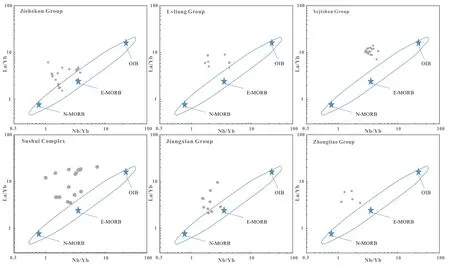
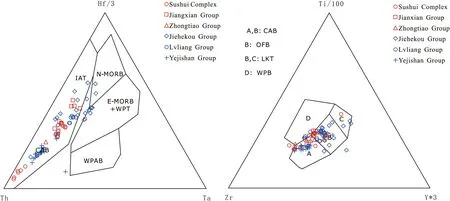
Fig.18 Hf/3-Th-Ta and Ti/100-Zr-Y*3 distinguishing diagrams of the meta-maf ic rock samples in this study
The Yejishan Group meta-maf ic rocks have also similar geochemical features to those of calc-alkaline basalts from mature island arc systems(Wang et al.2015).In the La/Yb versus Nb/Yb diagram(Fig.16),the samples have a relatively high La/Yb ratio,and all fall above the E-MORB and OIB f ields.In the(Hf/Sm)versus(Nb/La)(Fig.17)diagram,all samples have relatively low(Nb/La)ratio and near or below chondritic(Hf/Sm)value,indicating that their mantle source region was modif ied by subduction-derived f luid metasomatic processes(Wang et al.2015).Liu et al.(2014a)reported positive zirconε(-t)(0.1–5.4)for the plagioclase amphibolite from the Bailongshan Formation (Yejishan Group),supporting a depleted mantle source.For the tectonic environment of the Yejishan Group,Geng et al.(2003)based on the single grain zircon U–Pb age of felsic tuff from Bailongshan Formation,believed that it was formed in the continental rift environment;Liu et al.(2009)believed that the Yejishan Group might be producted in the post-arc tectonic background at a side of the arc.Liu et al.(2011)according to the youngest detrital zircon age of the upper Yejishan Group to limit its oldest sedimentary age to~1.84 Ga,and considered that the Yejishan Group was formed in the foreland basin environment.Wang(2014)studied the geochemical characteristics of basalts from the Bailongshan formation,and concluded that these basalts have the characteristics of both intraplate basalts and continental margin island arc,and then speculated that the Yejishan Group was formed in the back-arc basin environment.In this study,the meta-maf ic rock samples from the Yejishan Group are relatively enriched in LILE and depletion of Nb,Ta,and Ti,which display the characteristics of island arc calc-alkali basalts.Moreover,on the Hf/3-Th-Ta and Ti/100-Zr-Y*3 distinguishing diagrams(Fig.18),these samples mainly plot in the calc-alkali basalts f iled.We are more inclined to believe that the Yejishan Group was formed in the compression environment of plate convergence.
For the Zhongtiaoshan meta-maf ic rocks,some samples from the Sushui Complex are geochemically similar to calc-alkaline basalts from mature island arc systems,whereas some others have IAT aff inity(Wang et al.2015).In the La/Yb versus Nb/Yb diagram(Fig.16),the samples contain a relatively high La/Yb ratio,and all fall above the N-MORB and OIB f ields.In the(Hf/Sm)-(Nb/La)diagram(Fig.17),all samples have relatively low(Nb/La)ratio and chondrite-like(Hf/Sm)ratio,indicating that their mantle source region was modif ied by subductionderived f luid metasomatism(Wang et al.2015).Zhang(2015)reported positive zirconε(t)(5.4–7.4)for the Lengkou plagioclase amphibolite,suggestive of a depleted mantle source.At present,the tectonic setting of Sushui complex has been controversial.Tian et al.(2005)thought that the late Archean TTG rocks were a product of island arc magmatic;Zhang(2015)thought that the Lengkou amphibolite was formed in an intraplate environment according to the petrology,geochemistry,and isotope research results of amphibolite in Sushui complex;Yang et al.(2018)speculated that the Lengkou metavolcanic rocks were formed on the paleocontinental margin according to the island arc and collision structure characteristics of metavolcanic rocks;In this study,the metamaf ic rock samples from the Sushui complex are relatively enriched in LILE and depletion of Nb,Ta,and Ti,which display the characteristics of island arc calc-alkali basalts.Moreover,on the Hf/3-Th-Ta and Ti/100-Zr-Y*3 distinguishing diagrams(Fig.18),these samples mainly plot in the calc-alkali basalts f iled,and the calc-alkaline basalts are common aff inity to the island arc environment.To sum up,we prefer that the Sushui complex was formed in the compression environment of plate convergence.
Most Jiangxian Group samples have IAT aff inity,and a few samples have CAB aff inity(Wang et al.2015).In the La/Yb–Nb/Yb diagram(Fig.16),the samples have a relatively high La/Yb ratio,and most samples fall above the N-MORB and OIB f ields.In the(Hf/Sm)-(Nb/La)(Fig.17)diagram,most samples have relatively low(Nb/La)ratio and chondrite-like(Hf/Sm)ratio,indicating that their mantle source region was modif ied by subduction-derived f luid metasomatism(Wang et al.2015).Sun et al.(1991)reportedε(t)=+2.25 for the Tongkuangyu metamorphic bimodal volcanics(Jiangxian Group),again ref lecting a depleted mantle source.Previous studies of the Jiangxian Group have two main views on its tectonic setting,which are intra-continental rift and back-arc basin(Li et al.2009,2013;Zhang 2012;Chen et al.2014).In this study,the meta-maf ic rock samples from the Jiangxian Group are relatively enriched in LILE and depletion of Nb,Ta,and Ti.Moreover,on the Hf/3-Th-Ta distinguishing diagrams(Fig.18),these samples mainly plot in the calcalkali basalts and island arc tholeiite basalts f iled,and on the Ti/100-Zr-Y*3 distinguishing diagrams(Fig.18),these samples mainly plot in the calc-alkali basalts f iled.Therefore,we are more inclined to the Jiangxian Group was formed in the compression environment of plate convergence.
The Zhongtiao Group samples have largely CAB aff inity(Wang et al.2015).In the La/Yb-Nb/Yb diagram(Fig.16),the samples contain a relatively high La/Yb ratio,and all fall above the N-MORB and OIB f ields.In the(Hf/Sm)-(Nb/La)diagram(Fig.17),the samples have a relatively low(Nb/La)ratio and chondrite-like(Hf/Sm)ratio,indicating that their mantle source region was modif ied by subduction-derived f luid metasomatism(Wang et al.2015).Sun and Hu (1993)obtained ε(-t)=2.05–2.374 for the lower Zhongtiao Group meta-maf ic volcanics,indicating a depleted mantle source.For the tectonic environment of the Zhongtiao Group,Li et al.(2011)considered that the Zhongtiao Group was deposited in a back-arc basin within an active continental margin setting according to the geochemical characteristics and detrital zircon age of the metamorphic sedimentary rocks.Liu et al.(2012b)considered that the lower Zhongtiao Group was formed in the back-arc basin according to the rock assemblage of metaclastic rocks,carbonates,and metavolcanic rocks,and interpreted the Upper Zhongtiao Group as the product of a retro-arc foreland basin according to metaconglomerates,metasandstones,and their depositional ages.In this study,the meta-maf ic rock samples from the Zhongtiao Group are relatively enriched in LILE and depletion of Nb,Ta,and Ti,which display the characteristics of island arc calc-alkali basalts.Moreover,on the Hf/3-Th-Ta and Ti/100-Zr-Y*3 distinguishing diagrams(Fig.18),these samples mainly plot in the calcalkali basalts f iled.So we agree that the Zhongtiao Group was formed in the compression environment of plate convergence.
6.3 Origin of geochemical heterogeneity for maf ic rocks from the Lu¨liang-Zhongtiao rift
6.3.1 Lu¨liangshan region
Since the ages,we obtained do not support the Jiehekou Group to be the Lu¨liangshan basement,and thus only the geochemical similarity between the Lu¨liang and Yejishan Groups is discussed here.
According to the classif ication scheme of Neoarchean meta-maf ic volcanics from the North China Craton by Wang et al.(2015),the Lu¨liang and Yejishan Group metamaf ic rocks are all CAB-type,with a depleted mantle source modif ied by subduction-derived f luid metasomatism.In chondrite-normalized REE diagrams,the Lu¨liang and Yejishan Group meta-maf ic rocks have all gently rightinclining patterns(slight LREE enrichments and f lat HREE patterns).With the younging ages of the rocks,the total REE contents and degrees of LREE/HREE fractionation increase gradually.In primitive mantle-normalized multielement diagrams,maf ic rocks from both regions all show various enrichments in large ion lithophile elements(LILE;e.g.,Rb,K)and LREEs,as well as depletions in radioactive heat-emitting elements(e.g.,Th)and HFSEs(e.g.,Nb,Ta,and Ti).
6.3.2 Zhongtiaoshan region
In the Sushui Complex of the Zhongtiaoshan basement,CAB-type and IAT-type meta-maf ic rocks coexist.The overlying Jiangxian Group meta-maf ic rocks show mainly IAT-type and minor CAB-type characters.The younger Zhongtiao Group meta-maf ic rocks are dominantly IATtype.Their magmas were likely all sourced from the depleted mantle,which was modif ied by subductionderived f luid metasomatism.In the chondrite-normalized REE diagrams,meta-maf ic rocks from all the Sushui Complex,Jiangxian Group,and Zhongtiao Group have gently right-inclining patterns(slight LREE enrichments and f lat HREE patterns).With younging ages of the rocks,the total REE contents increase but the degrees of LREE/HREE fractionation decrease gradually.In the primitive mantle-normalized multi-element diagrams,the Zhongtiaoshan meta-maf ic rocks show similar(albeit different degrees)depletions in Nb,Ta and Ti.The Jiangxian Group samples are enriched in Ba,Rb,and K,but depleted in Th,similar to the underlying Sushui Complex.The Zhongtiao Group meta-maf ic rocks show similar Sr depletions to the underlying Sushui Complex.Besides,Sun and Hu(1993)yielded very similarε(t)values for the Zhongtiao Group(2.05–2.374)and Jiangxian Group(2.247),which are both lower than those of the Lu¨liang Group(4.0)(Zhang et al.1988).
Studies on the Zhongtiaoshan and Lu¨liangshan metamaf ic rocks reveal that in the Zhongtiaoshan region,the Paleoproterozoic Zhongtiao Group and the underlying Jiangxian Group meta-maf ic rocks have similar geochemical characteristics,whilst the Jiangxian Group is also geochemically similar to the Neoarchean–Paleoproterozoic basement meta-volcanics.Similarly in the Lu¨liangshan region,the Lu¨liang Group and Yejishan Group meta-maf ic volcanics share also similar geochemical characteristics,but are geochemically distinct from the coeval Jiangxian and Zhongtiao Group maf ic volcanics in the Zhongtiaoshan region,as demonstrated in immobile element ratios discrimination diagrams such as La/Yb versus Nb/Yb and Ba/La versus Sr/Nd(Fig.19).Oxygen isotope study on the North China cratonic nucleus(Ouyang et al.2002)revealed that the trend lines of the samples collected from the different continental nucleus are close to parallels the evolution line of the Earth-Moon,indicating that the Archean continental nucleus of North China originated from the solar system’s material;however,there are some differences in the intercepts of the different continental nucleus,indicating that the oxygen isotopic compositions and evolution trends of the different continental nucleus are different.The Caozhuang complex and the Zunhua–Qinglong greenstone belt in Eastern Hebei Province are formed with an age difference of nearly 0.8 Ga,but the four samples from these two regions form a straight line parallel to the Earth-Moon evolution line,which indicates that the characteristics of oxygen isotope composition have not changed with time.Therefore,they inferred that the differences of oxygen isotopic compositions in the different continental nuclei of the North China Craton are caused by the inheritance of the heterogeneity of isotopic compositions in the regional paleomantle source areas(Ouyang et al.2002).Considering also our f indings on the Zhongtiaoshan and Lu¨liangshan meta-maf ic rocks in this study,we found that the geochemical features of the late-stage magmatic rocks and the early-stage magmatic rocks in the same region are similar,but the geochemical features of rocks in different areas at similar ages are different.Therefore,we speculated that for a particular region,geochemical features of the late-stage magmatic rocks may mainly be inherited from those of their early-stage counterparts,and the geochemical heterogeneity of the rocks in different areas at the same age may be inherited the heterogeneity of the early stage.
7 Conclusions
1. Zircon U–Pb dating show that the Lengkou and Wenjiapo meta-maf ic volcanics from the Sushui Complex basement(Zhongtiaoshan)were formed at 2516±26 and 2494±31 Ma,respectively.The overlying Jiangxian Group and Zhongtiao Group metamaf ic volcanics were formed at~2213 and 2077±29 Ma respectively. In the Lu¨liangshan region,the Jiehekou Group and Lu¨liang Group metamaf ic volcanics were formed at 1998±23 and 2152±52 Ma,respectively.
2. CAB-typeandIAT-typemeta-maficrockscoexistin theSushuiComplex.TheoverlyingJiangxianGroup showsmainlyIATandminorCABaffinity,whilstthe ZhongtiaoGroupmeta-maficrocksaredominantly IAT-type.IntheLu¨liangshanregion,theLu¨liang GroupandYejishanGroupmeta-maficrocksareall CAB-type,withtheirmaficmagmaallsourcedfrom thedepletedmantle,whichwasmodifiedbysubduction-derivedfluidmetasomatism.
3. Geochemicalcomparisononthemeta-maficrocks fromtheLu¨liang–Zhongtiaoriftrevealsthatthelatestagemagmaticrocksprobablyhaveinheritedthe geochemicalfeaturesoftheearly-stagerocksfromthe sameregion.Geochemicalheterogeneityofrocksfrom differentareasislikelyinheritedfromtheheterogeneityinthemagmasourceregion.
Acknowledgements
WewouldliketothankMoFanqiforhelping withthefieldwork,andDr.FanYan(NorthwestUniversity)forthe fruitfuldiscussionduringthemanuscriptcomposition.Funding
ThisstudyissupportedbytheStrategicPriorityResearch Program (B)ofChinese Academy ofSciences (GrantNo.XDB18010105),andtheTalentstart-upfundofGuiyangUniversity(2019039510821).Availabilityofdataandmaterial
Notapplicable.CodeavailabilityNotapplicable.Declarations
Conflictofinterest
Onbehalfofallauthors,thecorresponding authorstatesthatthereisnoconflictofinterest.- Acta Geochimica的其它文章
- Heavy metal:a misused term?
- Enrichment characteristics and sources of the critical metal yttrium in Zhijin rare earth-containing phosphorites,Guizhou Province,China
- Evaluation of groundwater quality using pollution index of groundwater(PIG)and non-carcinogenic health risk assessment in part of the Gangetic Basin
- Adsorption removal of roxarsone,arsenite(III),and arsenate(V)using iron-modif ied sorghum straw biochar and its kinetics
- Spatial prediction and modeling of soil salinity using simple cokriging,artif icial neural networks,and support vector machines in El Outaya plain,Biskra,southeastern Algeria
- Episodic crustal growth and reworking at the southeastern margin of the North China Craton:evidence from zircon U-Pb and Lu-Hf isotopes of Archean tonalite-trondhjemite-granodiorite gneisses in the Bengbu-Wuhe area

